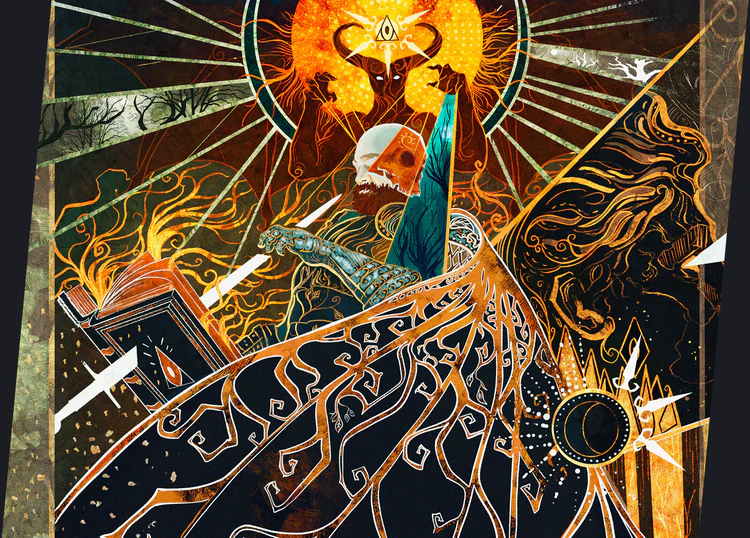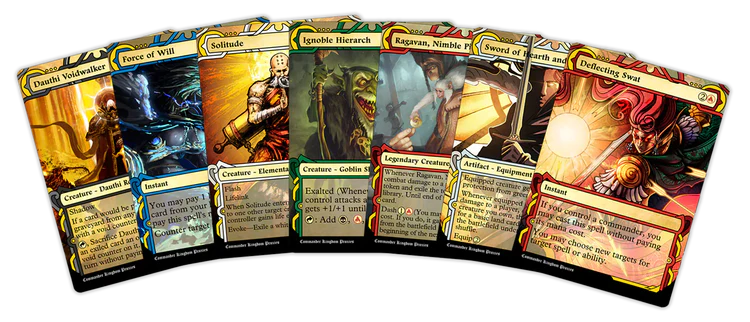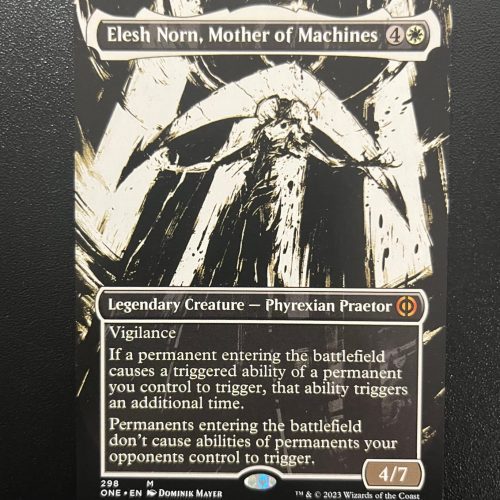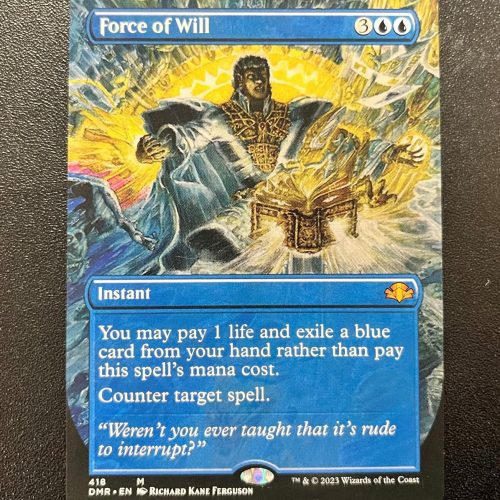
Quality MTG Proxy Cards
At Proxy MTG we make high quality custom proxy cards. We strive to offer the best quality, turnaround time, and service at a great price.
Featured MTG Proxies
Introducing Custom MTG Proxy Cards
Our new custom MTG Proxy Cards are made using unique artwork and designs. They are the same dimensions and weight as original cards so they fit in perfectly with your decks.

Shop by Card Color
Frequently Asked Questions
A proxy card is an easily acquired or home-made substitute for a collectible card. A proxy is used when a collectible card game player does not own a card, and it would be impractical for such purposes to acquire the card.
This usually occurs when a player desires a card that is cost-prohibitive, or is “playtesting” with many possible cards. When doing intensive training for a competitive tournament, it often makes more sense to use proxy cards while figuring out which cards will be brought to the tournament. Another card is substituted and serves the same function during gameplay as the actual card would.
A proxy can also be used in cases where a player owns a very valuable card, but does not wish to damage it by using it in actual play.
Proxy cards can be used in various situations. The rules and restrictions are object of common agreement, or a given policy, and may differ from the above-mentioned “fair play requirements”.
In casual games, the players may agree on a common policy of how to incorporate proxy cards. This allows to play a higher variation of card combinations and strategies, while keeping a limit on the expenses. In tournaments, the organizer may permit a limited number of proxy cards, and define rules about how these cards must look. This policy has become especially popular in games or formats where some vital cards are far too expensive, such as the vintage format inMagic: The Gathering.
For playtesting. Proxy cards allow a player to test new cards, before they decide to actually buy or trade for them. In card prototyping. Card developers in companies like Wizards of the Coast use proxies to playtest their ideas for new cards before they are printed.
Some players create cards based on their own ideas for card themes and mechanics. In this case, however, the term “proxy” may no longer be applicable, as these cannot be considered substitutes for existing objects.
Famous cards that are often proxied are the so-called power nine in Magic: The Gathering, which are considered totally out of balance in gameplay, while being unaffordable for the average player, due to their rarity and enormous price on the secondary market.
The main issue to guarantee fair play in a card game is that all cards in the deck must be indistinguishable for any player who does not view the front side (if card sleeves are used, the term ‘card’ means the sleeve with the card inside).
Ideally, all Magic cards (both original and proxy) should be indistinguishable in the following characteristics to ensure fairness:
Card size and shape, including the typical rounding cut on the edges.
The card’s total weight, its center of gravity and, ideally, the moment of inertia (which implies a homogeneous distribution of mass on the surface).
Overall and local stiffness and elasticity – all cards should behave equally on bending.
Overall and local thickness.
Feel and relief (tactile characteristics) of the MTG card, especially elevations and cavities on the surface on both sides.
The image printed on the back side, including its shininess.
Overall and local transparency, when examined with a light from behind.
Besides these physical implications, it should be considered that someone (the players or a judge) will need to control the validity of the cards – which may prove difficult with some of the above points.
At Proxy MTG our goal is to make sure that, when sleeved, it would be extremely difficult to distinguish your MTG proxy cards from your regular cards. This ensures fair play.
No, proxy cards are not allowed in official Magic the Gathering tournaments or sanctioned events, except under very specific circumstances (ie. a card is damaged during play). Only authentic, original MTG cards are allowed in such events. Using proxy cards in official tournaments could result in disqualification.
We believe so, depending on the context. In casual play settings where all players agree to their use, MTG proxy cards offer a more budget-friendly and accessible gaming experience. However, using Magic proxy cards to deceive others or gain an unfair advantage, especially in official tournaments, is considered unethical.
Magic: the Gathering (MTG) is a complex and strategic trading card game that involves two or more players battling each other using decks of cards representing magical spells, creatures, and artifacts. Here’s a basic overview of how to play the game:
Deck Construction: Each player needs a deck of at least 60 cards. Decks can be pre-constructed or custom-built, following specific deck-building rules such as a maximum of 4 copies of any one card, except for basic lands. Decks are typically built around a strategy or a combination of card synergies.
The Five Colors of Magic: MTG cards are divided into five colors, each representing a different aspect of magic:
- White: Order, protection, and healing
- Blue: Manipulation, control, and knowledge
- Black: Power, ambition, and death
- Red: Chaos, destruction, and impulsiveness
- Green: Growth, nature, and life
These colors often dictate the playstyle and strategy of a deck.
Starting the Game: Each player shuffles their deck and draws an opening hand of 7 cards. Players can mulligan (shuffle their hand back into the deck and draw a new hand with one less card) if they are not satisfied with their initial hand. After both players have chosen their starting hands, determine who goes first, usually by rolling a die.
Phases of a Turn: A player’s turn is divided into several phases, completed in the following order:
- Beginning Phase: Untap, Upkeep, and Draw
- First Main Phase: Play lands, cast spells, and summon creatures
- Combat Phase: Declare attackers, declare blockers, and deal combat damage
- Second Main Phase: Play additional lands, cast more spells, and summon more creatures
- Ending Phase: End step and Cleanup
Playing Lands and Casting Spells: Each turn, players can play one land card from their hand. Lands produce mana, the resource required to cast spells and activate abilities. The mana cost of a spell or ability is indicated in the top right corner of the card. To cast a spell, tap the required lands to generate the necessary mana and pay the spell’s cost.
Creatures and Combat: Creatures are a crucial part of the game, as they are often the primary way to deal damage to your opponent. Each creature has a power (the amount of damage it deals in combat) and toughness (the amount of damage it can take before being destroyed). During the combat phase, players can choose to attack with their creatures, and opponents may choose to block with their own creatures.
Winning the Game: Players start the game with 20 life points (40 in commander). The primary objective is to reduce your opponent’s life points to zero, either through combat damage from creatures or direct damage from spells and abilities. Alternatively, a player may win through alternative win conditions, such as achieving a specific game state or forcing the opponent to draw from an empty deck.
These are just the basics of playing Magic: the Gathering. The game offers an extensive range of cards, mechanics, and interactions that make it a deeply strategic and rewarding experience.
From video games, to Lego, to Pokemon to Magic, we are collectors and gamers at heart.
But most of all Magic.
We care about making sure that your cards are very well made and we are always adding new cards to our shop.
We have a fast turnaround time. Most orders are shipped out within one business day, however sometimes orders may take two or three days to fulfill, although this is pretty rare. We want you to get your Magic cards soon. Also, since we are based in the United States, you can typically expect shipping to be around a week for standard.























